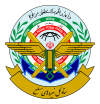Related Research Articles
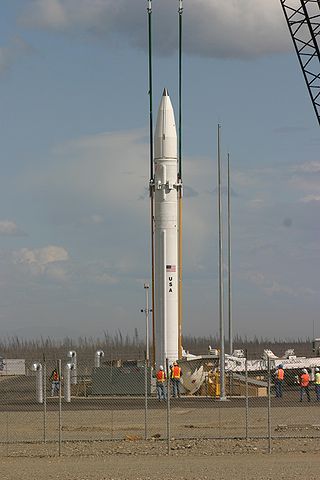
An anti-ballistic missile (ABM) is a surface-to-air missile designed to counter ballistic missiles. Ballistic missiles are used to deliver nuclear, chemical, biological, or conventional warheads in a ballistic flight trajectory. The term "anti-ballistic missile" is a generic term conveying a system designed to intercept and destroy any type of ballistic threat; however, it is commonly used for systems specifically designed to counter intercontinental ballistic missiles (ICBMs).

An intercontinental ballistic missile (ICBM) is a ballistic missile with a range greater than 5,500 kilometres (3,400 mi), primarily designed for nuclear weapons delivery. Conventional, chemical, and biological weapons can also be delivered with varying effectiveness, but have never been deployed on ICBMs. Most modern designs support multiple independently targetable reentry vehicle (MIRVs), allowing a single missile to carry several warheads, each of which can strike a different target. The United States, Russia, China, France, India, the United Kingdom, Israel, and North Korea are the only countries known to have operational ICBMs.

A ballistic missile is a type of missile that uses projectile motion to deliver warheads on a target. These weapons are powered only during relatively brief periods—most of the flight is unpowered. Short-range ballistic missiles stay within the Earth's atmosphere, while intercontinental ballistic missiles (ICBMs) are launched on a sub-orbital flight.

The Shahab-3 is a liquid-propelled medium-range ballistic missile (MRBM) developed by Iran and based on the North Korean Nodong-1. The Shahab-3 has a range of 1,000 kilometres (620 mi); a MRBM variant can now reach 2,000 kilometres (1,200 mi). It was tested from 1998 to 2003 and added to the military arsenal on 7 July 2003, with an official unveiling by Ayatollah Khamenei on July 20. With an accuracy of about 2,500 m CEP, the Shahab-3 missile is primarily effective against large, soft targets. Given the Shahab-3’s payload capacity, it would likely be capable of delivering nuclear warheads. According to the IAEA, Iran in the early 2000s may have explored various fuzing, arming and firing systems to make the Shahab-3 more capable of reliably delivering a nuclear warhead.

A medium-range ballistic missile (MRBM) is a type of ballistic missile with medium range, this last classification depending on the standards of certain organizations. Within the U.S. Department of Defense, a medium-range missile is defined by having a maximum range of between 1,000 and 3,000 kilometres. In modern terminology, MRBMs are part of the wider grouping of theatre ballistic missiles, which includes any ballistic missile with a range of less than 3,500 kilometres (2,200 mi).
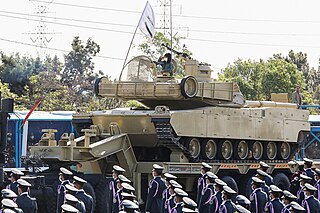
Zulfiqar (ذوالفقار) is an Iranian main battle tank, conceived by Brigadier General Mir-Younes Masoumzadeh, deputy ground force commander for research and self-sufficiency of the armed forces. It is named after Zulfiqar, the legendary sword of Ali, the fourth Caliph and the first Shiite Imam. It's also known as Zolfaqar.
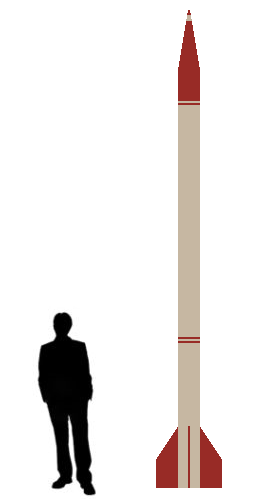
The Iranian Oghab sometimes spelled as Akab and Okab missile is an unguided 230 mm (9 in) artillery rocket with a range of 34–45 km (20–28 mi). It is spin-stabilized in flight but has a proven circular error probable in excess of 500 m (1,500 ft), making it a highly inaccurate weapon. It carries a 70 kg (150 lb) high explosive fragmentation warhead, though it may also be able to carry chemical warheads. According to US sources, a modified version has been developed that could be carried and fired from Iranian Air Force F-14 Tomcat and F-4 Phantom II aircraft. The launcher is an elevatable triple-rail launcher assembly fitted to a Mercedes-Benz LA 911B 4×4 truck chassis.
The Islamic Revolutionary Guard Corps Aerospace Force or Islamic Revolutionary Guard Corps Air and Space Force is the strategic missile, air, and space force within the Islamic Revolutionary Guard Corps (IRGC) of Iran. It was renamed from the IRGC Air Force into the IRGC Aerospace Force in 2009.
The Surya missile ('Sun') is a speculated intercontinental ballistic missile being developed by Defence research and development organization of India. Its operational range is beyond 16,000 Km, covering the entire earth.

Sejil, or Sejjil, is a family of Iranian solid-fueled medium range ballistic missiles. The Sejil are replacements for the Shahab liquid-fueled ballistic missiles. According to US Pentagon sources, the missile profile of the Sejil closely matches those of the Ashura, Ghadr-110 and the Samen. The Sejil-2 was seen in the Great Prophet 15 war games conducted by Iran on the 15th of January, 2021.
Shahab-6 is the designation of an alleged Iranian long-range ballistic missile project.
Shahab-5 is Iranian long-range ballistic missile, that was rumoured to exist as early as 1998. Estimated to be based on the North Korean Taepodong-2 with a first stage based on the Soviet RD-0216. Potential range of the missile is estimated to be between 4,000 and 4,300 km with a warhead payload of 700 to 1,000 kg.
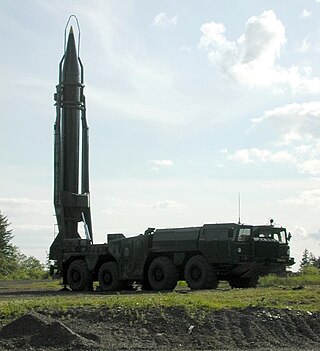
A Scud missile is one of a series of tactical ballistic missiles developed by the Soviet Union during the Cold War. It was exported widely to both Second and Third World countries. The term comes from the NATO reporting name attached to the missile by Western intelligence agencies. The Russian names for the missile are the R-11, and the R-17Elbrus. The name Scud has been widely used to refer to these missiles and the wide variety of derivative variants developed in other countries based on the Soviet design.

Hassan Tehrani Moghaddam was an Iranian military officer in the Aerospace Force of the Islamic Revolutionary Guard Corps and designer of Iran's ballistic missile project. He was the chief of the Army of the Guardians of the Islamic Revolutionary Guard Corps. He founded Iran's long-range missile program and sought the expertise and blueprint designs from North Korea in order to help develop Iran's missile technology. He designed the Shahab, Ghadr and Sejjil missiles with an operational range of more than 1,000–2,000 kilometres to target Israel. For these reasons he is regarded as the father of Iran's missile program. He was killed on 12 November 2011 in the Bid Kaneh explosion, at a military base belonging to the Islamic Revolutionary Guard Corps 25 miles west of Iran's capital, Tehran.
The RD-0216 and RD-0217 are liquid rocket engines, burning N2O4 and UDMH in the oxidizer rich staged combustion cycle. The only difference between the RD-0216 and the RD-0217 is that the latter has not a heat exchanger to heat the pressuring gasses for the tanks. Three RD-0216 and one RD-0217 were used on the first stage of the UR-100 ICBM. The engines were manufactured until 1974 and stayed in operational use until 1991. More than 1100 engines were produced.

The RD-250 (GRAU Index 8D518) is the base version of a dual-nozzle family of liquid rocket engines, burning N2O4 and UDMH in the gas-generator open cycle. The RD-250 was developed by OKB-456 for Yangel's PA Yuzhmash ICBM, the R-36 (8K67). Its variations were also used on the Tsyklon-2 and Tsyklon-3 launch vehicles. It was supposed to be used on the Tsyklon-4, but since the cancellation of the project it should be considered as out of production.
The Hwasong-14, also known under alternative US designation codename KN-20, is a mobile intercontinental ballistic missile developed by North Korea. It had its maiden flight on 4 July 2017, which coincided with the United States' Independence Day. North Korea is the only known operator of this missile.

The Hanyang HY4330 is a large model of military tractor trucks developed and produced by the Hanyang Special Purpose Vehicle Institute, which in turn is used by the People's Republic of China. These trucks behave essentially like conventional transporter erector launchers and as such, are used primarily to offer Beijing second strike nuclear capabilities; bolstering China's ballistic missile capabilities.
References
- ↑ Cordesman, Kleiber: Iran's Military Forces and Warfighting Capabilities Greenwood Publishing Group, 1989
- ↑ Ilan Berman: Tehran Rising Rowman & Littlefield, 2007
- ↑ Washington Report on Middle East Affairs, December 2002, pages 84-88
